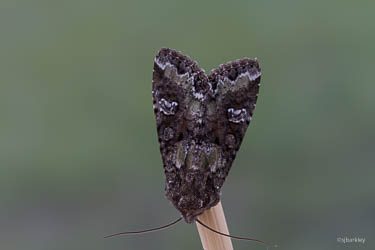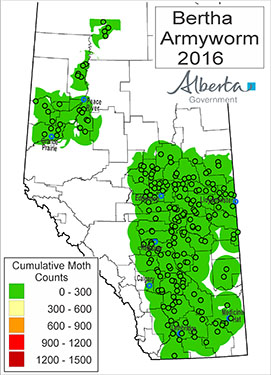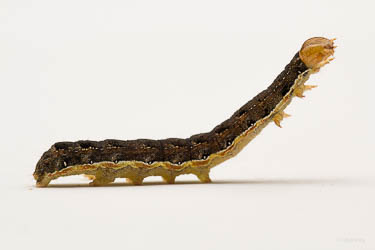| |


Bertha armyworm adult
Shelley Barkley, Alberta Agriculture and Forestry |

Click here for a larger map |

Bertha armyworm larva
Shelley Barkley, Alberta Agriculture and Forestry |
Bertha armyworm (Mamestra configurata) was monitored in 2016 using a network of pheromone-baited traps placed in 215 locations throughout Alberta.
Pheromone traps are used to determine the density and distribution of moths. This network of pheromone traps is organized by Alberta Agriculture and Forestry and individual traps are managed by a wide range of cooperators. Without dedicated and willing cooperators such a comprehensive monitoring system would not be possible. Our cooperators can submit their trap counts using their smart phones with a web based application.
The bertha armyworm population in Alberta is currently at a very low level with no serious populations or spraying reported in 2016. This is likely due to the impact of diseases and parasitism in the areas that previously had high populations.
It is difficult to accurately predict the 2017 bertha armyworm population based on the 2016 moth catch but the trend appears to be lower populations in almost all regions of the province. The trap system will be important to capture any resurgence that may take place in 2017. In addition research has clearly shown that snow covers encourages successful overwintering. Once again it will be critical to have very good coverage of pheromone traps in 2017 to develop an early warning of potential problems during the coming growing season.
Bertha armyworm populations are normally kept in check by such factors as weather and natural enemies. Generally parasitism rates of 50 - 60 per cent in bertha larval populations have indicated the end of a local outbreak in the following year. As we saw in 2013 epizootic events (disease outbreaks) can have a major impact on the bertha armyworm populations. Only by continuing the monitoring program will we be properly prepared each season. In addition maintaining the monitoring even in low flight years allows us to pick up trends and better predict when new major outbreaks are starting.
Six years of Bertha armyworm maps at a glance.
Potential damage from bertha armyworm may be more or less severe than suggested by the moth count data depending on weather and crop conditions and localized population dynamics. An insecticide application is recommended when the larval numbers meet the economic threshold .
The Alberta Bertha armyworm forecasting program has been done since 1995. Provincial government personnel, industry agronomists, Applied Research Associations, Agricultural Fieldmen and cooperating growers maintain the pheromone trap network. The cumulative moth count maps are maintained by Alberta Agriculture and Forestry.
During the monitoring season the map is a Google map which means you can move around, zoom in and click on the individual balloons. By clicking on a balloon it will show the organization that looked after that trap, what municipality the trap is in, the weekly count and cumulative count (all counts displayed are the average between the two traps at a site). During the trapping season the information is updated as the entries are made into the data collection website. The resolution is not accurate enough to pinpoint the exact location of individual traps.
The objective of the monitoring is to increase the awareness of canola producers to the damage potential of bertha armyworm. Forecast maps DO NOT replace field scouting. No field should be treated for bertha armyworm control without proper field scouting. Moth catches indicate the potential for damage but the actual populations must be assessed. Experience from 2012 has shown us that adjacent fields or even different parts of the same field can have greatly different bertha armyworm numbers.
For more information on this insect and its management contact the Ag-Info Centre at 310-FARM (3276) or bugs.r.us@gov.ab.ca
Thank you to the many cooperators that make this system so successful.
Thank you David Giffen, Agriculture and Agri-Food Canada, Saskatoon for translating the trap data into this map.
Thank you to the Alberta Agriculture and Forestry, Information Management Section Application Developers and Web coordinators for building and maintaining the online data collection system.
Thank you to Jan Lepp, Alberta Agriculture and Forestry for managing data collection.
Historic Bertha armyworm population maps. |
|